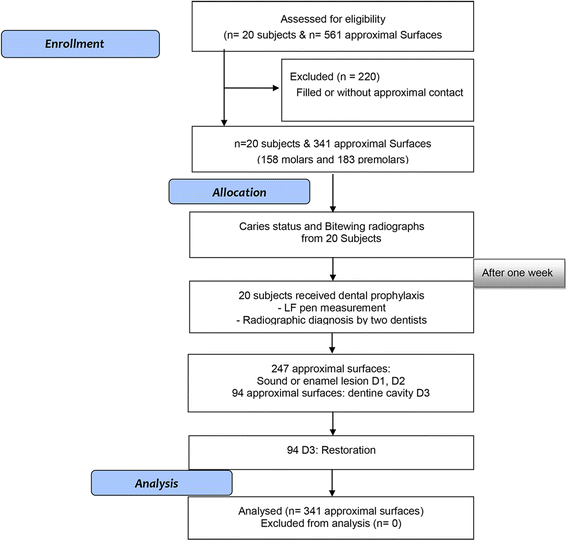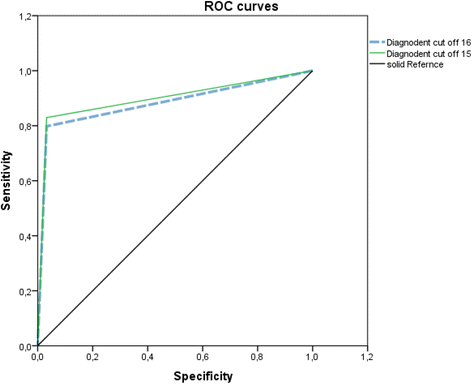Pen-type laser fluorescence device versus bitewing radiographs for caries detection on approximal surfaces
- PMID: 27809872
- PMCID: PMC5095970
- DOI: 10.1186/s13005-016-0126-9
Pen-type laser fluorescence device versus bitewing radiographs for caries detection on approximal surfaces
Abstract
Background: The accurate detection of approximal caries is generally difficult. The aim of this study was to assess the ability of the pen-type laser fluorescence device (LF pen) to detect approximal carious lesions in comparison to bitewing radiographs (BW).
Methods: Three hundred forty-one tooth surfaces were diagnosed in 20 patients with an average age of 26.70 (±2.82) years. Each test tooth was sequentially assessed by a single calibrated examiner using visual inspection, BW, and the LF pen. Radiographs were used as the gold standard to calculate an appropriate cut-off.
Results: Sensitivity, specificity and accuracy values for cut-off limits of 15, measured by the LF pen were compared using the chi2 test (McNemar test). For approximal caries at D3 level, the highest values of specificity and sensitivity were observed for the LF pen at a cut-off value of 15 (96.8 and 83.0 %) and for visual inspection (99.3 and 4.3 %).
Conclusion: Within the limitations of this study, dentin caries on approximal surfaces could be detected equally well by the LF pen as by the bitewing radiographs. Therefore, the LF pen can be recommended as an alternative to radiographs for the detection of approximal caries in a regular dental practice setting.
Trial registration: DRKS00004817 on DRKS on 12th March 2013.
Keywords: Approximal; Caries; Dentin caries; Detection; Pen-type laser fluorescence device; Radiography; Sensitivity; Specificity.
Figures
Similar articles
-
The performance of conventional and fluorescence-based methods for occlusal caries detection: an in vivo study with histologic validation.J Am Dent Assoc. 2012 Apr;143(4):339-50. doi: 10.14219/jada.archive.2012.0176. J Am Dent Assoc. 2012. PMID: 22467694
-
In vitro performance of a pen-type laser fluorescence device and bitewing radiographs for approximal caries detection in permanent and primary teeth.Indian J Dent Res. 2014 Nov-Dec;25(6):702-10. doi: 10.4103/0970-9290.152165. Indian J Dent Res. 2014. PMID: 25728100
-
The diagnostic accuracy of a laser fluorescence device and digital radiography in detecting approximal caries lesions in posterior permanent teeth: an in vivo study.Lasers Med Sci. 2017 Apr;32(3):621-628. doi: 10.1007/s10103-017-2157-2. Epub 2017 Feb 14. Lasers Med Sci. 2017. PMID: 28194533 Free PMC article.
-
Alternative methods to visual and radiographic examinations for approximal caries detection.J Oral Sci. 2017 Sep 14;59(3):315-322. doi: 10.2334/josnusd.16-0595. Epub 2017 May 19. J Oral Sci. 2017. PMID: 28529280 Review.
-
Diagnostic accuracy of artificial intelligence for approximal caries on bitewing radiographs: A systematic review and meta-analysis.J Dent. 2024 Dec;151:105388. doi: 10.1016/j.jdent.2024.105388. Epub 2024 Oct 11. J Dent. 2024. PMID: 39396775
Cited by
-
Effects of healthcare policy and education on reading accuracy of bitewing radiographs for interproximal caries.Dentomaxillofac Radiol. 2021 Feb 1;50(2):20200153. doi: 10.1259/dmfr.20200153. Epub 2020 Aug 14. Dentomaxillofac Radiol. 2021. PMID: 32795199 Free PMC article.
-
Use of Digital Diagnostic Aids for Initial Caries Detection: A Review.Dent J (Basel). 2023 Sep 28;11(10):232. doi: 10.3390/dj11100232. Dent J (Basel). 2023. PMID: 37886917 Free PMC article. Review.
-
Visual or visual-tactile examination to detect and inform the diagnosis of enamel caries.Cochrane Database Syst Rev. 2021 Jun 14;6(6):CD014546. doi: 10.1002/14651858.CD014546. Cochrane Database Syst Rev. 2021. PMID: 34124773 Free PMC article.
-
A comparison of diagnosis of early stage interproximal caries with bitewing radiographs and periapical images using consensus reference.Dentomaxillofac Radiol. 2019 Feb;48(2):20170450. doi: 10.1259/dmfr.20170450. Epub 2018 Sep 21. Dentomaxillofac Radiol. 2019. PMID: 30222021 Free PMC article.
-
Emerging Technologies for Dentin Caries Detection-A Systematic Review and Meta-Analysis.J Clin Med. 2022 Jan 28;11(3):674. doi: 10.3390/jcm11030674. J Clin Med. 2022. PMID: 35160127 Free PMC article. Review.
References
-
- Smith NJ. Risk assessment: the philosophy underlying radiation protection. Int Dent J. 1987;37(1):43–51. - PubMed
Publication types
MeSH terms
LinkOut - more resources
Full Text Sources
Other Literature Sources
Medical



